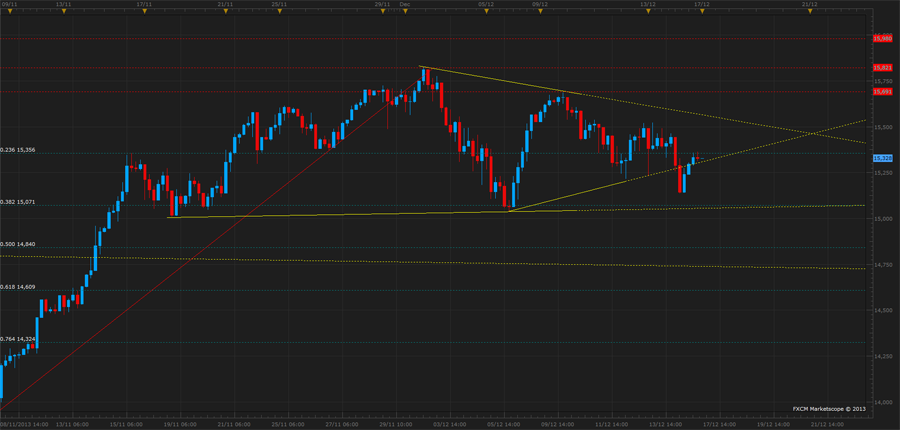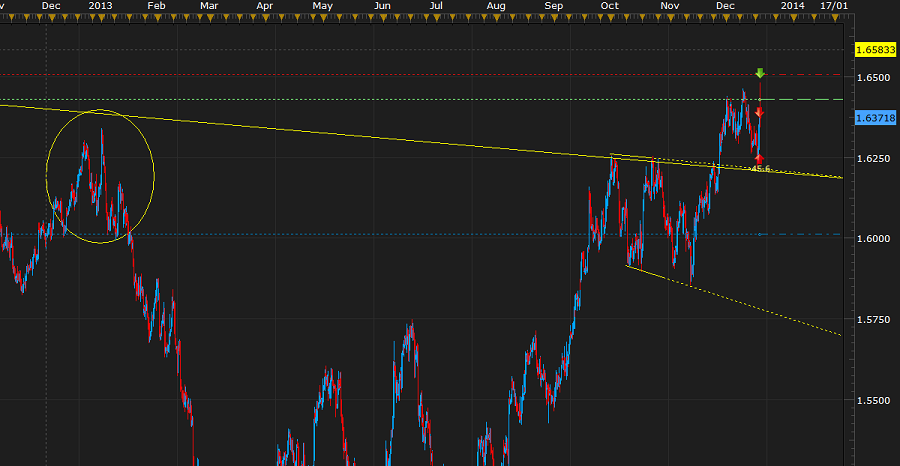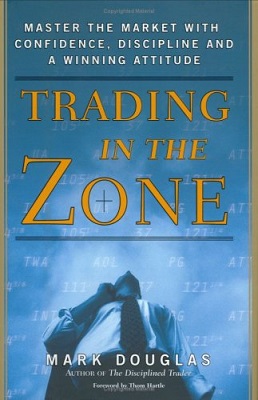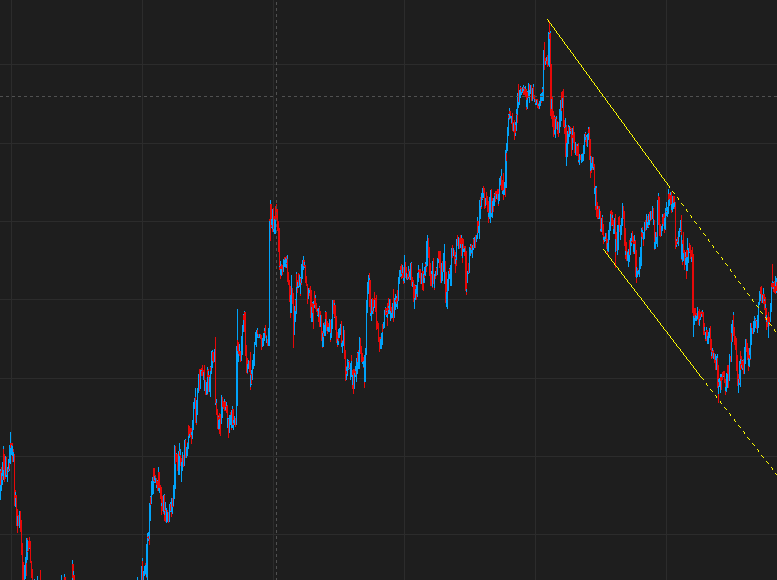Trading in the zone with Chase
You can revisit his previous days here and here.

You’ve got to get your game face on when trading the FOMC
Hi everyone! Welcome to Day 4.
I’m writing this while watching the aftermath of the post-FOMC press conference, and I have to say I’m happy at how things turned out. We finally got more than a sign from the Fed, EUR/USD is hitting small stops below 1.3700, the Nikkei’s at a 7 month high, Gold’s taking a long look at $1,200 and I’m in a couple of good trades.
I’m going to give a quick update on some of the trades I’ve mentioned so far this week, and then talk a little bit about finding inner peace.
Firstly, my USD/JPY long was trailed out at breakeven, but shortly after I finished today’s post (last night), I managed to re-enter small at 102.90, because I saw this:

nikkei 4hr
Because a new higher low had been formed in USD/JPY I was able to place a stop at 102.40, and my targets remain 105.00 and 110.00. A good thing I did, because as Adam mentioned this breakout is not a joke.
Other trades:
- Closed AUD/USD short from last week at 0.8880 for +130. AUD/USD hit new 3-year lows. Record number of down days as well…
- Both GBP/JPY long (full size) and AUD/JPY short (half-size) I posted about on Tuesday were triggered. Closed GBP/JPY at 169.00 for +194 pips to avoid being overly short JPY into the event, and I closed the AUD/JPY for -62. A good hedge.
- NZD/USD long was never triggered, and I stayed out of EUR/USD.
- GBP/USD short from last week was trailed out at breakeven on today’s UK data. Had taken half off for +80 pips.
- In the wake of that, I sold EUR/GBP at 0.842 (key reversal at descending trend line). It’s gone in a straight line since then and I have taken half off for +70.
- Was stopped out of EUR/CAD short from last week for -57 pips. This was the only trade that didn’t fit my strategy, and I’ve learnt from that.
- Scalped 35 pips off AUD/USD on the spike up after the event. Tried to be clever and lost -20.
- Lastly, I took another small GBP/USD short at 1.643, because I saw something I recognized:

GBPUSD 4hr
Cable often behaves erratically at turns, and in most cases makes one or two last ditch attempts at the extremes before reversing. It’s not clear on my chart but I still consider Cable to be inside the 2009-to-now wedge and I see it holding.
My target is at 1.600 but I will watch the reaction at 1.6250 closely. The stop on that trade is already at break-even, because losing money on it now would just be a shame, and I can always try again.
So all in all I’m up 300 pips on the week (at full size) not counting open trades, and my current risk is zero since all other stops are at break-even. I guess putting my n*%$ on the block here made me pay attention

Right. Inner peace.
What I want to talk about today is part trading psychology and part strategy, and they’re vaguely related. Just like everyone here, I’ve had to learn the hard way who my worst enemy is. They don’t teach that at BabyPips.
This bit is much more for new traders, so anyone who is comfortably secure in their profitability can skip to the good bit at the end.
I doubled my first live trading account in the first month, and lost every penny the next. I spent a few months wildly overtrading, buying things because they were going up, and generally doing everything you can to be a terrible trader. The one good thing I did though was keep a record of it all.
I didn’t lose a lot of money in any real terms, but the losses stung. However, I’d started to learn some good things about trading and about myself. Things that demo trading and stock picking had never taught me. Because the demo losses didn’t count I never learnt from them, and I’d never really lost in equities.
If you haven’t read it, I highly suggest picking up a copy of this book:

Trading in the Zone, by Mark Douglas (Penguin Books, 2000).
He gets a bit New-Agey when he bangs on about “negative energy flows”, but he does drop some excellent nuggets about mastering the mental game. These things should be obvious, but on your own it takes hundreds of hours of trading, and a lot of losses, before you start to get the right mind frame.
And even then, if you blow a big chunk of money right off the bat, you could just say the whole game is rigged and you might as well buy BitCoin.
And you’d be half right. The game is rigged.
But not in a, “my broker wants to hunt my stop and steal my 200 bucks” kind of way.
Trading is about probabilities and opportunities. The best we can do is try to reliably put ourselves on the right side of those odds. If the game is rigged, then it’s rigged in favour of the house. And there’s nothing stopping you from trading like the house.
I was talking to a friend at work who used to be a professional poker player. I know very little about playing at that level, but I was trying to explain to him why trading wasn’t gambling. I told him that we use a pre-defined risk/reward ratio, and manage our position sizing to ensure that a losing streak doesn’t wipe us out.
He said they also do that – only in a more aggressive way. Then he asked me if I can ever be certain about the odds of my trade working out. I said no way – not even the best quants can reliably do that.
He said he could do it in his head in few seconds when he was playing poker.
Right when I was about to transfer my trading account to PaddyPower I started thinking about the odds, and it was fortunate that my copy of Trading in the Zone arrived the next day.
Douglas gives an exercise to teach you to see yourself as a casino – mindlessly applying the edge you have developed, and relying on the probabilities and a big enough sample size to make you profitable. Along the way it teaches you to view winning and losing as part of the game, and not reflections on your character or abilities.
The exercise is simple:
- Pick a strategy. Doesn’t have to be a great one, but it has to have strict rules for entering and exiting trades.
- Choose one or two markets you’re comfortable with.
- Make 20 trades with your strategy. Use real money – you’re not testing a strategy, you’re learning how you handle real losses.
- Execute your trades strictly according to the strategy. No dicking around, no chopping positions, no sneaky something-something on the side during this time.
- Take money off the table when the market makes it available.
- Trail your stop at a predefined point.
- Take final profit at your target, not before.
(Douglas, M. Trading in the Zone. London, Penguin Books, 2000. Pp 189 – 192)
By the end of that exercise I had gained a huge amount of confidence. Not in my skill as a technical analyst, but in my ability to lose money with grace and trust my strategy. My account was up a little over 10% in about 2 weeks, and I knew that my technical approach was sound enough to average profitable trades (note that I don’t say winning trades).
A big part of Douglas’ idea is to create a belief that you’re a consistent winner, even if you weren’t one today and yesterday. That’s why taking part profits isn’t just to limit risk – it’s so that you’ll frequently have the experience of winning, even when a trade doesn’t totally work out.
If the strategy doesn’t work it doesn’t matter. You can find a better one. What’s important is to learn to think like the casino.
The casino rigs the game, and all the punters know it. But the game is only slightly rigged in the house’s favour. So little that plenty of guests walk out winners. The house only needs to win 53% of the time, because you’ll come back tomorrow.
That way there’s no pressure on the casino to get better at the game. It doesn’t need to agonize over the losses. It just needs to get punters through the doors and the odds will work themselves out.
Keeping this in mind is a huge part of my trading approach, and one of my biggest challenges. A losing streak sucks. A streak of losing streaks can make you want to chuck it in. But once you learn to think like the house, and to fully accept your risk of loss before you even enter a trade, life gets a lot easier.
That’s it for thinking like the house. But what about trading like it?
Someone in the /r/forex sub on Reddit – which is a great little community especially for newbies – taught me very early on to try and think like the big money. This is made easier by things like the Order Boards posted here on ForexLive, which speak volumes about where supply and demand are.
Here’s a mystery chart:

randomchart 1hr
If you saw this, you might conclude that a bull flag was breaking. We have a larger up trend, a correction in 2 waves, and then a break and retest of the descending channel top.
Here’s the full chart:
AUDUSD 4hr
If you saw the above and went long, you definitely weren’t the only one. And it was a good trade idea if you were bullish.
I wasn’t. My view might have been a tad simplistic – Australia’s economy wasn’t doing well, commodities were going down, and risk appetite was getting sketchy. On that basis I had a bearish bias. The year-long down trend retracing to 50% and resuming was the technical justification for my bias.
I was already heavily short, but I wanted to be more short. However, I didn’t want to add with a 200 pip stop to a trade that was already risk-free. I considered a few things:
- The dollar was excessively weak during this period, and sold off whenever nobody was looking.
- There hadn’t been much market-moving data from Australia lately, and there was a lot of two-way action.
- Liquidity was very thin, which aided the short squeezes
I identified the grey zone as one where a lot of consolidation had taken place – buyers and sellers fought it out over this zone plenty of times. The ideal situation would have been a rejection at the trend line, but the market was too thin and a bout of dollar weakness pushed price well above.
A quick dip and retest sent prices even higher, and then they suddenly stalled. We can only guess at who got in there, and why, and with how much, but someone somewhere had been waiting for that level, and so had I.
I knew that price was likely to push the absolute upper limit before backing down, and that weak stops would get hit. I half-expected it to test the 0.9530 area.
I was able to sell at 0.9420, only 20 pips from the highest it’s been since. I was only able to do that because I was firm in my bias – although a voice was yelling that I was wrong. I had to close Twitter because nobody would shut up about being long.
I was particularly proud of that trade. Partly because it went against the crowd (who were all being contrarians), but mostly because I had really looked at the chart, considered the market conditions, paid attention to where the stops and orders were, planned it thoroughly, watched and recognized the price action, and entered the way I planned.
All I really did was BTFD. But you could have bought that USD dip all the way from .0907 on good reasons. The difference was recognizing that a thin market wasn’t going to make it that easy.
Trading is a zero sum game. In order for us to make money, the folks at some other Forex news blog have to lose it. The mission I’ve given myself is to make this kind of thinking instinctive. To at least try and anticipate where the retail crowd is going to get mowed down, and be on the right side of it.
There are plenty of tools out there to help with that (and plenty who just call you a noob). The order boards, FXCM’s SSI though I find it a bit hit-and-miss – but mostly just price action. If you look at the right time frame, with the right eyes, you can almost see the point where the wave will roll back.
After that, all it takes is about 10,000 hours of chart time to get really good at it.
That’s it from me – I hope you all had a good FOMC day!
Chase




